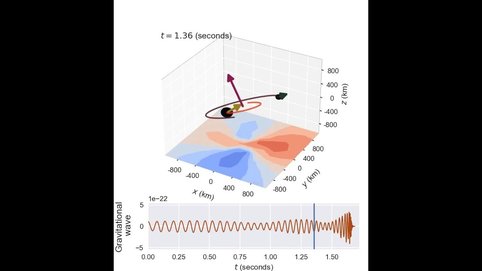Black holes on their way out: Postdoc award of the State of Brandenburg for Vijay Varma
Scientist at the Max Planck Institute for Gravitational Physics is honored for his innovative research on merging black holes
Dr. Vijay Varma develops models to catch black holes that are ejected after a merger with a velocity of thousands of kilometers per second. He succeeded for the first time in identifying such a “runaway” black hole in gravitational-wave detector data – thus laying the foundation for a new observational method. With this award, the state of Brandenburg honors outstanding research work by postdocs at universities and non-university research institutions. The prize is endowed with 20,000 euros.
“I am very honored by this amazing recognition of my research work,” says Varma. “I would like to thank my mentors throughout my career and acknowledge my LIGO-Virgo colleagues, as none of this would have been possible without these awesome detectors.”
First detection of a “runaway” black hole
When two black holes merge, gravitational waves are emitted. These ripples in space-time had already been predicted by Albert Einstein in 1916 and can be measured on Earth since September 2015. The signals carry information about the properties of the merging black holes, such as their mass and spin, as well as their position in space. Einstein's general theory of relativity, however, makes another striking prediction on this subject: after the merger, the newly formed black hole can get ejected at speeds reaching thousands of kilometers per second. Until recently, no conclusive experimental proof has been found for this theoretical prediction. But now Dr. Vijay Varma, Marie Curie Fellow in the department of Astrophysical and Cosmological Relativity at the Max Planck Institute for Gravitational Physics (Albert Einstein Institute), has found the first evidence of such a black hole being hurled away. Together with colleagues, he investigated the gravitational-wave event GW200129. The signal, captured on January 29, 2020, by the gravitational-wave detectors LIGO in the U.S. and Virgo in Italy, originated from the merger of a 40 solar-mass black hole with a 22 solar-mass partner.
GW200129
See https://vijayvarma392.github.io/GW200129/ for further details.
Bouncing black holes
In a fraction of a second, merging black holes emit a tremendous amount of energy in the form of gravitational waves. If the waves are more powerful in some directions than others, they can carry away momentum. In order to maintain the total momentum of the system, the center of mass of the binary star moves in the opposite direction, much like a gun bouncing back after firing a bullet. The newly formed black hole experiences a recoil velocity called a “kick”.
“The kick depends on the merger process. Einstein's equations describe the coalescence, and we use supercomputer simulations that solve these equations to calculate the kick,” Varma explains. In the system Varma studied, the resulting black hole was kicked away at 1500 km/s. Such kicks are larger than the escape velocity of most galaxies, which means that the final black hole can be ejected from its host galaxy. “Our kick measurement has opened up completely new observational prospects,” Varma says. “We can use it to explore the formation of heavy black holes and perform fundamental tests of Einstein's theory of relativity.”
Postdoctoral award from the State of Brandenburg
The Ministry of Science, Research and Culture awards the Postdoc Prize of the State of Brandenburg, each worth €20,000, annually in the categories of natural sciences and engineering, and humanities and social sciences. The award winners must use €10,000 of the prize money for scientific purposes; the remaining €10,000 is at their free disposal.
In addition to the prize money, the award winners receive a statue created by the Brandenburg artist Christian Roehl.












